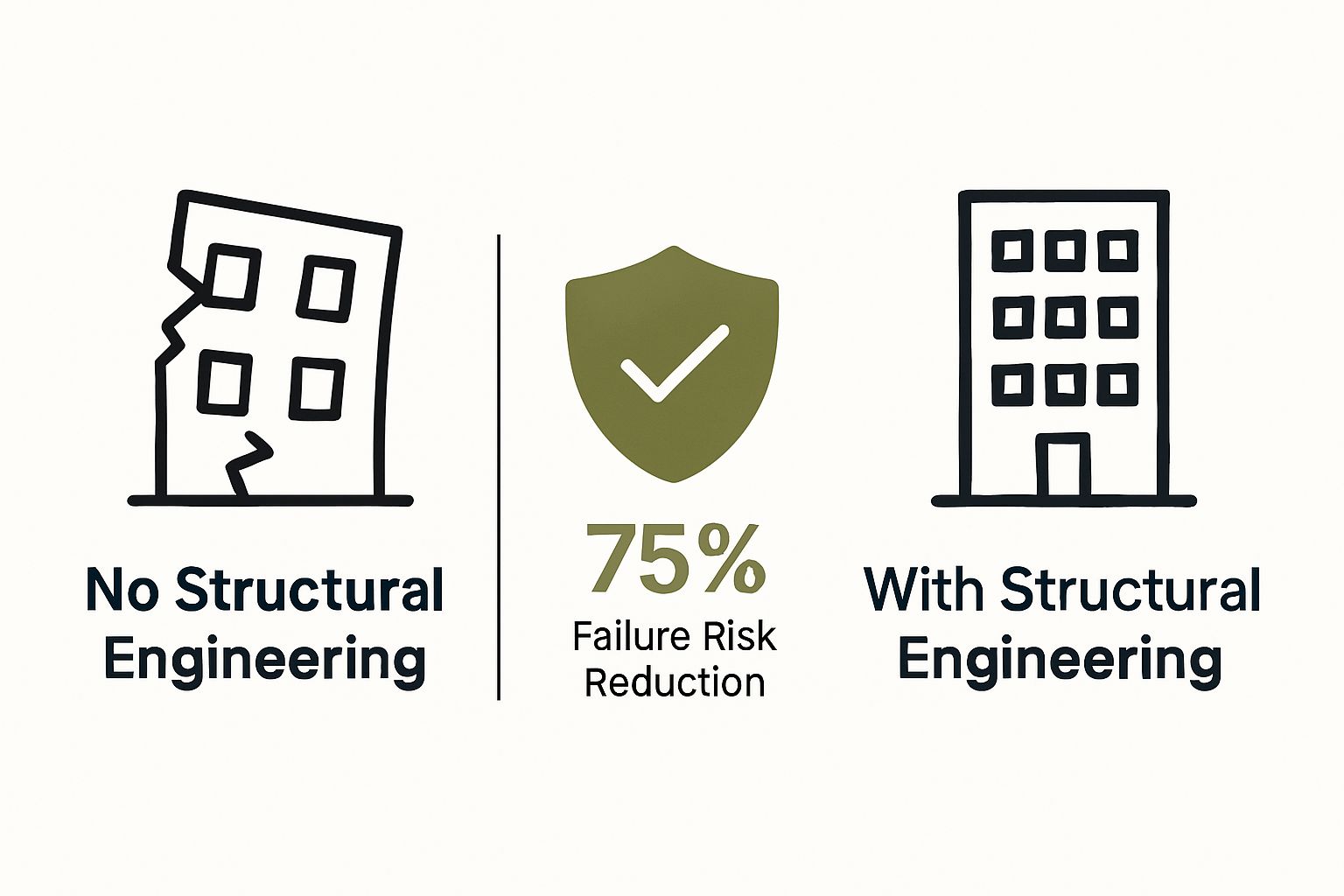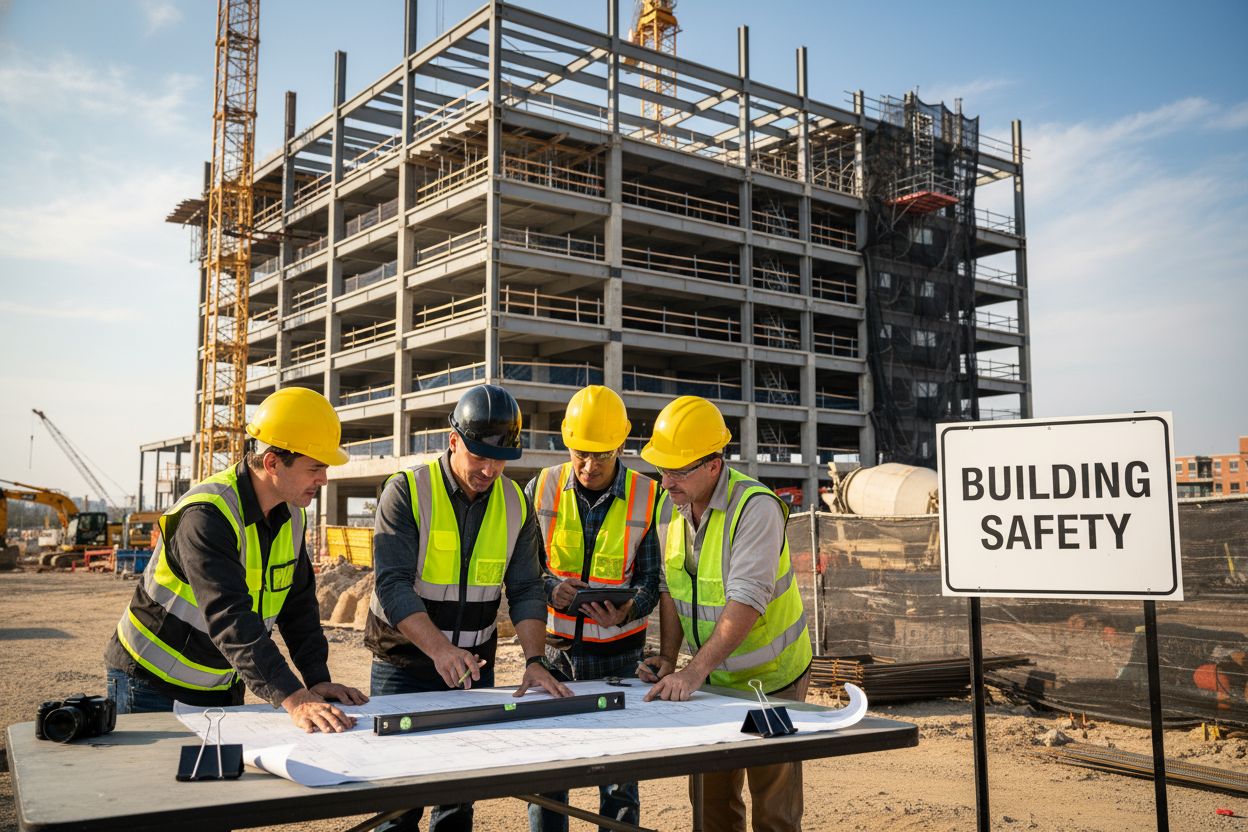What is Structural Engineering? Understanding Its Importance
Structural engineering shapes every building and bridge you trust with your safety. Most people think it is all about concrete, steel, and blueprints. Turns out, the smartest work happens long before a single brick is laid—strategic engineering can reduce lifecycle costs by up to 30 percent or even prevent catastrophic failures. This field is where architecture meets precision and creates solutions generations rely on.
Table of Contents
- Defining Structural Engineering: What It Is
- The Importance of Structural Engineering in Construction
- Core Concepts of Structural Engineering Explained
- How Structural Engineering Influences Building Safety
- Real-World Applications of Structural Engineering
Quick Summary
| Takeaway | Explanation |
|---|---|
| Structural Engineers Ensure Safety | They design structures to withstand environmental challenges, protecting lives. |
| Load Analysis is Crucial | Engineers evaluate various forces like static and dynamic loads for safety. |
| Compliance with Building Codes | Strict adherence to regulations reduces potential structural failures significantly. |
| Innovative Technology Enhances Safety | Advanced tech allows real-time monitoring of structures for proactive safety management. |
| Sustainable Design Improves Efficiency | Integrating green engineering principles lowers costs and minimizes environmental impact. |
Defining Structural Engineering: What It Is
Structural engineering is a specialized branch of civil engineering focused on designing and analyzing structures to ensure they can safely support and resist loads while maintaining stability and integrity. This discipline combines advanced mathematics, physics, and material science to create buildings, bridges, towers, and infrastructure that can withstand various environmental and mechanical stresses.
The Core Purpose of Structural Design
At its fundamental level, structural engineering aims to transform architectural visions into safe, functional, and durable physical structures. Engineers in this field must calculate precise load distributions, understand material properties, and anticipate potential stress factors that could compromise a structure’s performance. Their work involves complex mathematical modeling and computational analysis to predict how different materials and structural configurations will respond under various conditions.
Key Responsibilities of Structural Engineers
Structural engineers have multifaceted responsibilities that extend far beyond simple construction planning. Their critical tasks include:
- Conducting comprehensive structural assessments and risk evaluations
- Developing detailed architectural blueprints and technical drawings
- Selecting appropriate construction materials based on environmental and structural requirements
- Performing advanced mathematical calculations to determine load-bearing capacities
- Ensuring structures comply with local building codes and safety regulations
These professionals play a crucial role in creating resilient infrastructure that protects human lives and investments.
This table presents core responsibilities of structural engineers, organizing their diverse tasks for clear reference.
| Responsibility | Explanation |
|---|---|
| Structural Assessments and Risk Evaluations | Evaluate the safety, strength, and vulnerabilities of structures |
| Developing Blueprints and Technical Drawings | Produce detailed plans used in construction |
| Material Selection | Choose suitable construction materials based on environmental needs |
| Load-Bearing Calculations | Compute how much load every element can safely support |
| Code and Regulation Compliance | Ensure design meets all required building codes and safety standards |
| According to National Society of Professional Engineers, structural engineering requires extensive technical knowledge and continuous professional development to address increasingly complex architectural and engineering challenges. |
The discipline combines theoretical knowledge with practical application, requiring engineers to understand not just mathematical principles but also real-world environmental factors. From earthquake-resistant designs to sustainable building techniques, structural engineers are at the forefront of creating infrastructure that can adapt to changing environmental and technological landscapes.
The Importance of Structural Engineering in Construction
Structural engineering plays a critical role in transforming architectural concepts into safe, sustainable, and functional physical environments. Beyond mere construction, these professionals serve as guardians of public safety, ensuring that every building and infrastructure project meets stringent performance and durability standards.
Ensuring Public Safety and Structural Integrity
The primary objective of structural engineering in construction is protecting human lives by creating structures capable of withstanding complex environmental challenges. Engineers analyze potential risks like seismic activities, wind loads, temperature variations, and potential material fatigue to design resilient structures that can maintain their structural integrity under extreme conditions. Preventing catastrophic failures becomes the fundamental priority, requiring meticulous calculations and comprehensive risk assessments.
Economic and Long-Term Performance Considerations
Structural engineering extends far beyond immediate construction requirements. By implementing sophisticated design strategies, engineers optimize material usage, reduce long-term maintenance costs, and enhance overall building performance. Key economic benefits include:
- Minimizing potential structural repair expenses
- Increasing building lifespan through intelligent design
- Reducing energy consumption through strategic structural configurations
- Enhancing property value through superior engineering standards
According to National Institute of Building Sciences, strategic structural engineering can reduce lifecycle costs by up to 30% while significantly improving building resilience and sustainability.
Technological Innovation and Sustainability
Modern structural engineering integrates cutting-edge technologies and sustainable practices to address contemporary environmental challenges. Engineers now incorporate advanced computational modeling, smart materials, and green design principles to create structures that are not only functionally superior but also environmentally responsible. Florida Licensed Engineers understands this evolving landscape, continuously adapting engineering approaches to meet emerging technological and environmental standards.
Through comprehensive analysis, innovative design, and rigorous testing, structural engineers transform abstract architectural visions into tangible, safe, and efficient physical environments that serve communities for generations.
Here is a comparison of how structural engineering impacts key areas of construction, summarizing direct benefits described in the article.
| Area | Impact of Structural Engineering |
|---|---|
| Public Safety & Integrity | Prevents catastrophic failures, ensures buildings withstand environmental challenges |
| Economic & Lifecycle Costs | Reduces repair expenses, increases lifespan, optimizes energy usage, boosts value |
| Innovation & Sustainability | Promotes use of green practices, modern technology, and advanced materials |
Core Concepts of Structural Engineering Explained
Structural engineering encompasses a complex set of scientific principles and mathematical methodologies designed to understand how physical structures respond to various forces and environmental conditions. These core concepts form the foundational knowledge that enables engineers to design safe, efficient, and resilient buildings and infrastructure.
Load Analysis and Force Distribution
Load analysis represents the cornerstone of structural engineering, involving precise calculations that determine how different forces interact with and impact structural elements. Engineers must comprehensively evaluate multiple types of loads:
- Static loads: Constant forces like the weight of building materials
- Dynamic loads: Temporary or changing forces such as wind, earthquakes, or human movement
- Environmental loads: Pressures created by temperature variations, humidity, and atmospheric conditions
By understanding these complex interactions, structural engineers can design structures capable of withstanding anticipated and unexpected stress scenarios.
Below is a table summarizing the main types of loads structural engineers must analyze, along with their definitions and examples from the article.
| Load Type | Definition | Example from Article |
|---|---|---|
| Static Load | Constant forces that do not change over time | Weight of building materials |
| Dynamic Load | Temporary or changing forces impacting a structure | Wind, earthquakes, human movement |
| Environmental Load | Pressures resulting from natural environmental conditions | Temperature variations, humidity |
Material Science and Structural Behavior
Material selection and understanding material properties are critical in structural engineering. Different materials exhibit unique characteristics under various stress conditions. Concrete, steel, wood, and composite materials each respond differently to load distributions, requiring engineers to develop sophisticated mathematical models that predict structural performance.
According to American Society of Civil Engineers, advanced computational modeling now allows engineers to simulate material behaviors with unprecedented accuracy, enabling more precise and reliable structural designs.
Structural Systems and Design Principles
Structural engineers employ comprehensive design principles that go beyond simple load-bearing calculations. They must consider holistic system interactions, integrating architectural vision with engineering precision. This involves understanding how individual structural components collaborate to create cohesive, stable systems that can adapt to dynamic environmental challenges.
Key design principles include:
- Ensuring redundancy in structural systems
- Minimizing potential failure points
- Creating flexible yet stable architectural configurations
- Implementing sustainable and resilient design strategies
Through meticulous analysis, advanced computational techniques, and deep scientific understanding, structural engineers transform complex mathematical principles into tangible, safe, and innovative physical structures that shape our built environment.
How Structural Engineering Influences Building Safety
Structural engineering serves as the primary defense mechanism in protecting human lives by creating buildings and infrastructure that can withstand complex environmental challenges and potential catastrophic events. Safety is not merely an afterthought but the fundamental principle guiding every structural design and engineering decision.
Risk Mitigation and Structural Resilience
Structural engineers implement sophisticated strategies to minimize potential risks and enhance building safety. Comprehensive risk assessment involves analyzing multiple potential scenarios that could compromise structural integrity. This includes evaluating potential environmental threats like earthquakes, hurricanes, heavy snow loads, and potential material degradation over time.
Key risk mitigation strategies involve:
- Implementing advanced computational modeling to predict structural performance
- Conducting detailed material stress analyses
- Developing redundant structural support systems
- Creating flexible design configurations that can absorb and distribute unexpected forces
These strategies ensure that structures can withstand extreme conditions while maintaining occupant safety and minimizing potential structural failures.
Compliance and Safety Standards
Structural safety extends beyond theoretical calculations and requires strict adherence to rigorous building codes and regulatory standards. Engineers must navigate complex regulatory landscapes, ensuring that every structural design meets or exceeds local, state, and federal safety requirements.
According to National Institute of Standards and Technology, adherence to comprehensive safety standards can reduce potential structural failures by up to 60% and significantly enhance overall building resilience.

Advanced Technologies in Safety Engineering
Modern structural engineering leverages cutting-edge technologies to enhance safety protocols. Advanced sensor technologies and real-time monitoring systems now allow engineers to continuously assess structural health, detecting potential weaknesses before they become critical issues.
Emergent technologies like machine learning algorithms and advanced computational simulations enable Florida Licensed Engineers to create increasingly sophisticated safety assessment methodologies. These innovations transform traditional reactive approaches into proactive, predictive safety management strategies that protect human lives and infrastructure investments.

Real-World Applications of Structural Engineering
Structural engineering transcends theoretical concepts, manifesting in diverse practical applications that shape our physical environment and infrastructure. From towering skyscrapers to intricate bridges and specialized facilities, structural engineers transform complex mathematical principles into tangible, functional structures that serve critical societal needs.
Infrastructure and Urban Development
Large-scale infrastructure projects represent the most visible manifestation of structural engineering expertise. Engineers design and implement critical transportation networks, municipal buildings, and urban development frameworks that support modern civilization. These complex projects require sophisticated integration of architectural vision with precise engineering calculations.
Key infrastructure applications include:
- Designing earthquake-resistant bridges and overpasses
- Creating sustainable urban transit systems
- Developing resilient municipal buildings
- Constructing complex transportation interchanges
Specialized Facility Engineering
Beyond traditional construction, structural engineering plays a pivotal role in developing specialized facilities that demand extraordinary technical precision. Research laboratories, medical facilities, data centers, and industrial complexes require unique structural considerations that go far beyond standard building practices.
According to American Society of Civil Engineers, specialized facility design demands intricate understanding of environmental interactions, technological requirements, and potential future adaptability.
Sustainable and Adaptive Structural Solutions
Modern structural engineering increasingly focuses on creating adaptive, environmentally responsive structures that can evolve with changing technological and ecological landscapes. Green engineering principles now guide structural design, emphasizing energy efficiency, material sustainability, and minimal environmental impact.
Emergent design strategies include:
- Integrating renewable energy infrastructure
- Developing structures with modular, adaptable configurations
- Implementing advanced thermal and acoustic engineering techniques
- Creating buildings that generate minimal carbon footprint
Florida Licensed Engineers exemplifies this forward-thinking approach, demonstrating how structural engineering continuously adapts to address complex contemporary challenges while maintaining rigorous safety and performance standards.
Transform Your Project With Reliable Structural Engineering Services
Understanding structural engineering is essential if you want buildings that are safe, resilient, and built to last. If the complexity of load analysis, material selection, or meeting local safety standards feels overwhelming, you are not alone. Many project owners struggle with balancing cutting-edge design and strict regulations. You may wonder if your project is truly engineered to stand up to Florida’s unique demands. If you ever face challenges such as unclear blueprints, slow permitting, or doubts about compliance, professional support makes all the difference. Our engineering team at Florida Licensed Engineers brings you clarity and confidence with end-to-end solutions tailored for both commercial and residential needs.

Get peace of mind knowing your project will be expertly inspected, designed, and permitted to the highest Florida standards. Whether you need detailed structural plans, forensic investigation, or help with site grading and code compliance, Florida Licensed Engineers is ready to help you move forward right now. Visit our main site or see how our expertise supports complex projects by exploring the Uncategorized Archives – Georgial Licensed Engineers. Take the next step and give your property lasting value and unmatched safety.
Frequently Asked Questions
What is structural engineering?
Structural engineering is a specialized branch of civil engineering focused on designing and analyzing structures to ensure they can safely support and resist loads while maintaining stability and integrity.
What are the key responsibilities of structural engineers?
Structural engineers are responsible for conducting structural assessments, developing architectural blueprints, selecting materials, performing load calculations, and ensuring compliance with building codes and safety regulations.
How does structural engineering ensure public safety?
Structural engineering ensures public safety by designing structures that can withstand environmental challenges such as earthquakes, wind loads, and temperature variations, thereby preventing catastrophic failures.
What role does technology play in modern structural engineering?
Modern structural engineering leverages advanced technologies like computational modeling, smart materials, and real-time monitoring systems to enhance design accuracy, structural safety, and sustainability.




